#Planck size
Explore tagged Tumblr posts
Text
Against and For Evolution
WHY STATISTICAL MECHANICS NEGATES EVOLUTION Found on Facebook by Mark Champneys There are 3 billion base pairs in human DNA sequences. This is an arranged molecule of staggering size. The information content of DNA is rooted in the extreme improbability of those relatively few arrangements that code for life, in stark contrast to the vast number of possible sequence arrangements that are…
View On WordPress
#3 billion base pairs#Biologists#Charles Darwin#Eukaryotes#Evolution#favoured races#macroscopic evolution#Planck size#prokaryotes.#Quantum#quantuum mechanics of evolution#Richard Dawkins
0 notes
Text
"A little more of the same, Jane. What matter the planetesimal hypothesis or the quantum theory compared to such a dinner? Come, Jane, don't tell me you're ignorant of the quantum theory. A woman may get by without knowing about the planetesimal hypothesis but the quantum theory, Jane, is a necessity in any well-regulated household."
People are so very concerned with quantum mechanics in books written in the 30s.
I mean, I understand it was a very significant development at the time, but I'm still surprised that I've seen multiple novelists comment on it as a Significant Thing in the News.
#and by this I mean that I was just rereading Gaudy Night and they make jokes about Planck's constant#so my sample size is two#not a lot#but it's weird that it happened twice#l m montgomery#jane of lantern hill#lantern hill book club#physics
10 notes
·
View notes
Text
Ask A Genius 1014: Quantum world informational fidelity shading
Rick Rosner, American Comedy Writer, www.rickrosner.org Scott Douglas Jacobsen, Independent Journalist, www.in-sightpublishing.com Scott Douglas Jacobsen: Have you ever seen a slider of an image enhancer? You can slide a vertical line left to right. It allows a before and after back-and-forth of the image, like a before and after acne treatment commercial or something. If Planck-scale quantum…
#a universe with few particles#before and after acne treatment#define themselves in space limited#image enhancer vertical line adding fidelity#increase in size of universe#interactions among matter in universe#Planck-scale quantum systems function below#reasonable theory of universes increase
0 notes
Text









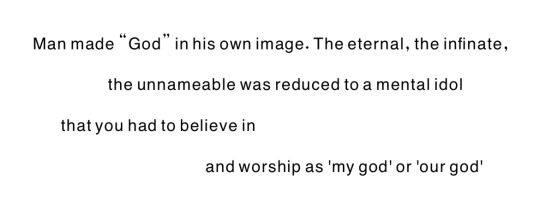







GOD SAID, LET NEWTON BE! AND ALL WAS LIGHT
"Paul Davies; // Guy Kawasaki; // "Flammarion engraving", Unknown (1888); // "Portrait of Jean Mielot", by Jean Le Tavernier (1456); // "The New science: 3 complete works: Where is science Going?, The Universe in the Light of Modern Physics, The Philosophy of Physics", by Max Planck; // "Science, Philosophy, and Religion", by Albert Einstein; // Allan Sandage in "Sizing up the Cosmos: An Astronomer's Quest", interviewed by John Noble Wilford; // Louis Pasteur; // AWAKE experiment, CERN (2019); // Eckhart Tolle; // Voltaire; // "A Brief History of Time. ch 11", by Stephen Hawking; // St. John Cristal Casket; // Ralph Waldo Emerson; // Robert Winston; // "George Baker", Unknown artist (17th century); // "Cours de philosophie à Paris. Grandes chroniques de France", Unknown artist (14th century)
#webweaving#web weaving#webweave#web weave#religion#science#techology#god#science vs religion#they are the same#comparatives#poem#poetry#quote#aesthetic#spilled ink#spilled poetry#spilled thoughts
115 notes
·
View notes
Text

The Planck length is another thousand or two pixels below the comic.
Depth [Explained]
Transcript
Title: Sizes Accurate on a vertical log scale.
[Series of images of characters doing various things. The things they are doing are listed in left to right order.] Cueball and Megan playing in a ball pen Megan using witchcraft to ban vista "Out, Vista!" Ponytail and Megan play Rock Band A couple is having sex under the cover in bed.
[Below this series of images, an image of a man on the computer.] Cueball is on a computer and the image expands as it goes down. Here are the labels from left to right, up to down: CD DVD Case North Bridge PS/2 Mouse (rodent) RAM CPU Socket Pin 32,767 Angels Dancing (one more and they'd roll over and become 32,768 Devils), Rice, Torrent (a bug), CPU, upcoming segfault dust mite hair OVUM Data (a pixel on Rick Astley's shoulder), rust mite, fork(); Peter Norton fighting a bacteriophage memory carbon nanotubes space elevator a line of silicon (Si), Electron Cloud, a man made out of arrows saying "sup?" silicon nucleus IPod femto Brian Greene knitting furiously [next to his knitting needles there is text saying ''clink, clink'']
50 notes
·
View notes
Text

Astronomers take the first close-up picture of a star outside our galaxy
“For the first time, we have succeeded in taking a zoomed-in image of a dying star in a galaxy outside our own Milky Way,” says Keiichi Ohnaka, an astrophysicist from Universidad Andrés Bello in Chile. Located a staggering 160 000 light-years from us, the star WOH G64 was imaged thanks to the impressive sharpness offered by the European Southern Observatory’s Very Large Telescope Interferometer (ESO’s VLTI). The new observations reveal a star puffing out gas and dust, in the last stages before it becomes a supernova.
“We discovered an egg-shaped cocoon closely surrounding the star,” says Ohnaka, the lead author of a study reporting the observations published today in Astronomy & Astrophysics. “We are excited because this may be related to the drastic ejection of material from the dying star before a supernova explosion.”
While astronomers have taken about two dozen zoomed-in images of stars in our galaxy, unveiling their properties, countless other stars dwell within other galaxies, so far away that observing even one of them in detail has been extremely challenging. Up until now.
The newly imaged star, WOH G64, lies within the Large Magellanic Cloud, one of the small galaxies that orbits the Milky Way. Astronomers have known about this star for decades and have appropriately dubbed it the ‘behemoth star’. With a size roughly 2000 times that of our Sun, WOH G64 is classified as a red supergiant.
Ohnaka’s team had long been interested in this behemoth star. Back in 2005 and 2007, they used ESO’s VLTI in Chile’s Atacama Desert to learn more about the star’s features, and carried on studying it in the years since. But an actual image of the star had remained elusive.
For the desired picture, the team had to wait for the development of one of the VLTI’s second-generation instruments, GRAVITY. After comparing their new results with other previous observations of WOH G64, they were surprised to find that the star had become dimmer over the past decade.
“We have found that the star has been experiencing a significant change in the last 10 years, providing us with a rare opportunity to witness a star’s life in real time,” says Gerd Weigelt, an astronomy professor at the Max Planck Institute for Radio Astronomy in Bonn, Germany and a co-author of the study. In their final life stages, red supergiants like WOH G64 shed their outer layers of gas and dust in a process that can last thousands of years. "This star is one of the most extreme of its kind, and any drastic change may bring it closer to an explosive end," adds co-author Jacco van Loon, Keele Observatory Director at Keele University, UK, who has been observing WOH G64 since the 1990s.
The team thinks that these shed materials may also be responsible for the dimming and for the unexpected shape of the dust cocoon around the star. The new image shows that the cocoon is stretched-out, which surprised scientists, who expected a different shape based on previous observations and computer models. The team believes that the cocoon’s egg-like shape could be explained by either the star’s shedding or by the influence of a yet-undiscovered companion star.
As the star becomes fainter, taking other close-up pictures of it is becoming increasingly difficult, even for the VLTI. Nonetheless, planned updates to the telescope’s instrumentation, such as the future GRAVITY+, promise to change this soon. “Similar follow-up observations with ESO instruments will be important for understanding what is going on in the star,” concludes Ohnaka.
More information
ESO’s Very Large Telescope Interferometer is able to combine light collected by the telescopes of ESO’s Very Large Telescope (VLT), either the four 8-metre Unit Telescopes or the four smaller Auxiliary Telescopes, creating highly detailed pictures of the cosmos. Effectively, this makes the VLTI a “virtual” telescope with a resolution equivalent to the maximum distance between the individual telescopes. This process is highly complex and needs instruments especially dedicated to this task. Back in 2005 and 2007 Ohnaka’s team had access to the first generation of these instruments: MIDI. While impressive for its time, those observations with MIDI only combined the light from two telescopes. Now, researchers have access to GRAVITY, a second-generation instrument able to capture the light of four telescopes. Its improved sensitivity and resolution made the image of WOH G64 possible. But there is more to come. GRAVITY+ is a planned upgrade of GRAVITY which will be able to take advantage of different technological updates performed at the VLTI and VLT. With these, the VLTI will be able to see objects fainter and farther than ever before.
IMAGE: This is an image of the star WOH G64, taken by the GRAVITY instrument on the European Southern Observatory’s Very Large Telescope Interferometer (ESO’s VLTI). This is the first close-up picture of a star outside our own galaxy, the Milky Way. The star is located in the Large Magellanic Cloud, over 160 000 light-years away. The bright oval at the centre of this image is a dusty cocoon that enshrouds the star. A fainter elliptical ring around it could be the inner rim of a dusty torus, but more observations are needed to confirm this feature. Credit ESO/K. Ohnaka et al.
15 notes
·
View notes
Text
Caesar Clown is made out of gas.
Which means no amount of gravity can affect him. My man could be on the surface of the SUN and still be floatin around like nothing’s wrong.
He can float through walls.. he can likely float through entire mountains. He could float to the top of Mount Everest and not be the slightest bit winded, or have broken the slightest sweat.
However… space is a vacuum.
Put Caesar in space? Caesar go BOOM! Annihilated.
I know he can control gas and all— he might try to pull all of his particles together while in space. He might be able to do it, although it would be extremely difficult without trying to accidentally become an entire planet in the process (yes, that is how they— and stars— form).
Caesar can become a planet.
Caesar can become a star.
Caesar can become a tiny galaxy.
(I’m having a million epiphanies right now. Give me a minute.)
Caesar can become a moon, or basically any kind of celestial object. AND, if he condenses himself densely enough, he can become a Planck-sized black hole (what is a Planck? I believe it is the smallest size of an object ever discovered.)
He can also probably change the type of gas he is. And, with his ‘final form’, we see that Caesar can collect other gaseous particles to absorb, to add onto himself, to make him bigger, and stronger.
Which means Caesar can become a supermassive black hole, or a laws-of-physics-defying monster of a planet.
Caesar’s Devil Fruit is incredibly underrated….
#one piece#one piece strawhats#straw hat crew#straw hat grand fleet#straw hat pirates#strawhat pirates#caesar clown#trafalgardwaterlaw#trafalgar d water law#trafalgar law#trafalgar one piece#caesar clown x reader#one piece nami#one piece hawkins#one piece ace#one piece usopp#one piece spoilers#one piece marines#one piece sengoku#one piece navy#one piece fanfiction#one piece sanji#one piece brook#one piece jimbei#one piece caesar clown#one piece headcanons
324 notes
·
View notes
Text
THE UNIVERSE COULD BE FILLED WITH ULTRALIGHT BLACK HOLES THAT CAN'T DIE??
Blog#400
Saturday, May 11th, 2024.
Welcome back,
Primordial black holes are hypothetical objects formed during the earliest moments of the universe. According to the models, they formed from micro-fluctuations in matter density and spacetime to become sand grain-sized mountain-massed black holes.
Although we've never detected primordial black holes, they have all the necessary properties of dark matter, such as not emitting light and the ability to cluster around galaxies. If they exist, they could explain most of dark matter.
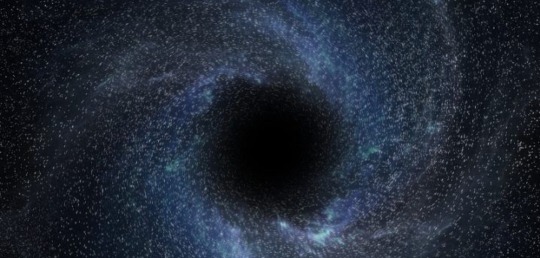
The downside is that most primordial black hole candidates have been ruled out by observation. For example, to account for dark matter there would have to be so many of these gravitational pipsqueaks that they would often pass in front of a star from our vantage point. This would create a microlensing flare we should regularly observe. Several sky surveys have looked for such an event to no avail, so PBH dark matter is not a popular idea these days.
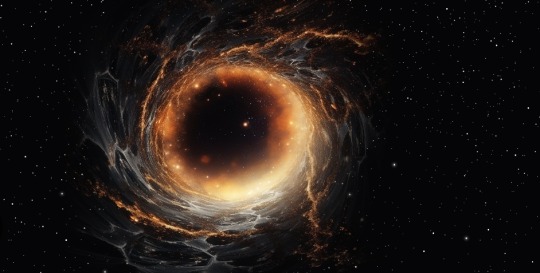
A new work, posted to the arXiv preprint server, takes a slightly different approach. Rather than looking at typical primordial black holes, it considers ultralight black holes. These are on the small end of possible masses and are so tiny that Hawking radiation would come into play.
The rate of Hawking decay is inversely proportional to the size of a black hole, so these ultralight black holes should radiate to their end of life on a short cosmic timescale.
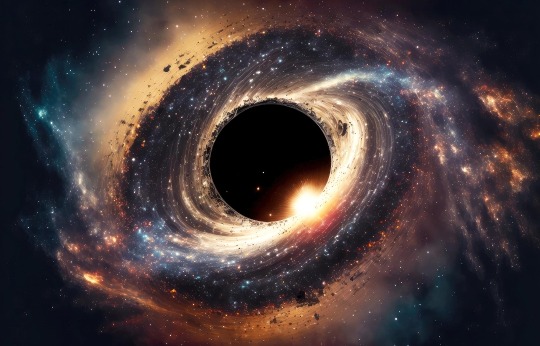
Since we don't have a full model of quantum gravity, we don't know what would happen to ultralight black holes at the end, which is where this paper comes in.
As the author notes, basically there are three possible outcomes. The first is that the black hole radiates away completely. The black hole would end as a brief flash of high-energy particles. The second is that some mechanism prevents complete evaporation and the black hole reaches some kind of equilibrium state. The third option is similar to the second, but in this case, the equilibrium state causes the event horizon to disappear, leaving an exposed dense mass known as a naked singularity.

The author also notes that for the latter two outcomes, the objects might have a net electric charge.
For the evaporating case, the biggest unknown would be the timescale of evaporation. If PBHs are initially tiny they would evaporate quickly and add to the reheating effect of the early cosmos. If they evaporate slowly, we should be able to see their deaths as a flash of gamma rays. Neither of these effects has been observed, but it is possible that detectors such as Fermi's Large Area Telescope might catch one in the act.

For the latter two options, the author argues that equilibrium would be reached around the Planck scale. The remnants would be proton-sized but with much higher masses. Unfortunately, if these remnants are electrically neutral they would be impossible to detect. They wouldn't decay into other particles, nor would they be large enough to detect directly. This would match observation, but isn't a satisfying result.
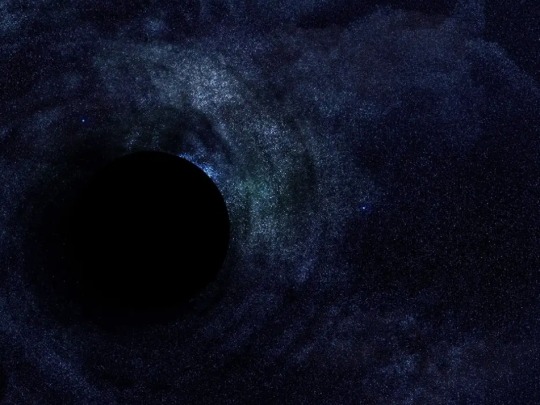
The model is essentially unprovable. If the particles do have a charge, then we might detect their presence in the next generation of neutrino detectors.
The main thing about this work is that primordial black holes aren't entirely ruled out by current observations. Until we have better data, this model joins the theoretical pile of many other possibilities.
Originally published on https://phys-org.
COMING UP!!
(Wednesday, May 15th, 2024)
"DOES THE UNIVERSE EXPAND BY STRETCHING OR CREATING SPACE??"
#astronomy#outer space#alternate universe#astrophysics#universe#spacecraft#white universe#space#parallel universe#astrophotography
53 notes
·
View notes
Text

“Dark Universe”
The huge mosaic released by ESA’s Euclid space telescope on October 15, 2024, accounts for 1% of the wide survey that Euclid will capture over six years.
The location and actual size of the mosaic on the Southern Sky is shown in yellow.
This all-sky view is an overlay of ESA Gaia’s star map from its second data release in 2018 and ESA Planck’s dust map from 2014.
Credit: ESA/Euclid/Euclid Consortium/NASA; ESA/Gaia/DPAC; ESA/Planck Collaboration
#art#cosmos#cosmic#universe#blast#space#wallpaper#stars#photography#dark universe#esa#euclid space telescope#southern sky#star map#nasa#gaia
14 notes
·
View notes
Text

Advanced microscopy method reveals hidden world of nanoscale optical metamaterials
Scientists from the Department of Physical Chemistry at the Fritz Haber Institute of the Max Planck Society have made a significant discovery in the field of nanotechnology, as detailed in their latest publication in Advanced Materials. Their paper, titled "Spectroscopic and Interferometric Sum-Frequency Imaging of Strongly Coupled Phonon Polaritons in SiC Metasurfaces," introduces a novel microscopy method that allows for the unprecedented visualization of nanostructures and their optical properties. Metamaterials, engineered at the nanoscale, exhibit unique properties not found in naturally occurring materials. These properties arise from their nanoscale building blocks, which, until now, have been challenging to observe directly due to their size being smaller than the wavelength of light. The team's research overcomes this limitation by employing a new microscopy technique that can simultaneously reveal both the nano and macro structures of these materials.
Read more.
15 notes
·
View notes
Text
youtube
Time is a compactified dimension one single Planck second in size. Using Kuramoto synchrony we evolve a hyperplane of the present with matter on one side and antimatter on the other. Each the perfect inverse of the other. This is how the universe is friction free.
An electron here only shows 1/2 of itself. It's shadow self, the positron, is on the other side of time. This is why CP violation.
We only get to see half of charged particles because the other half is on the other side of time. But neutral charge particles, neutrons, photons, are their own anti. They rest BALANCED on the surface of time. And both sides see them.
#science#physics#cosmology#youtube#topology#astrophysics#theoretical physics#mathematics#crackpot theories#freedom
2 notes
·
View notes
Text

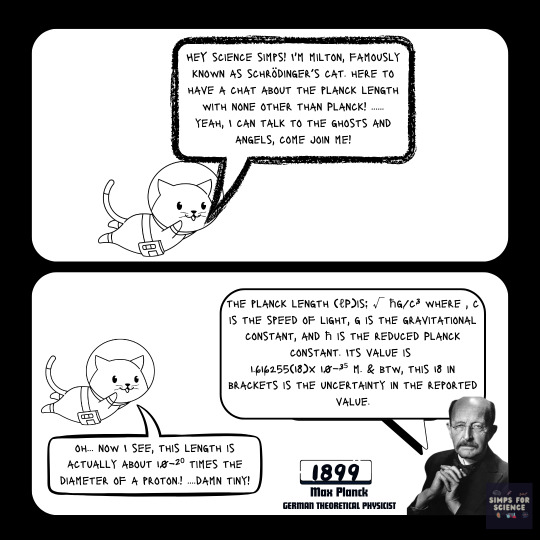
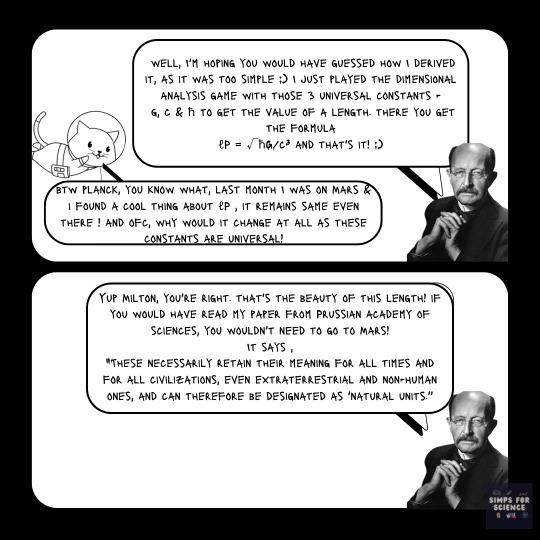

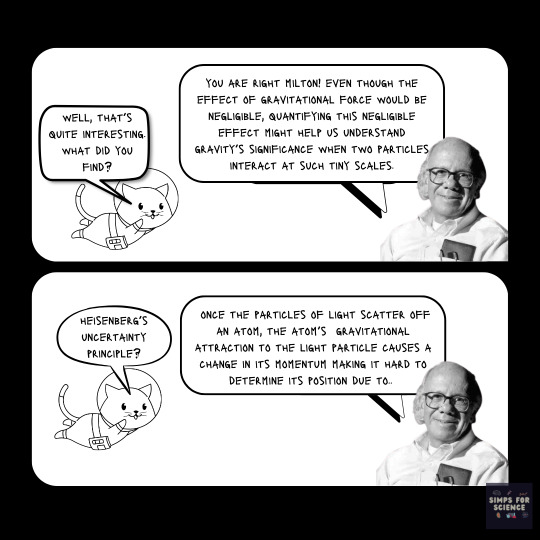
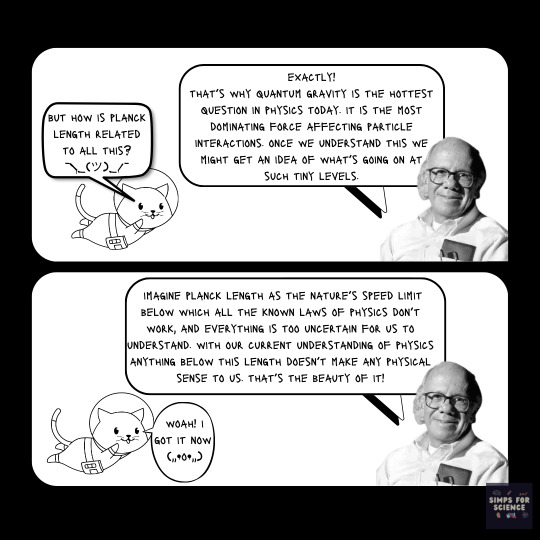
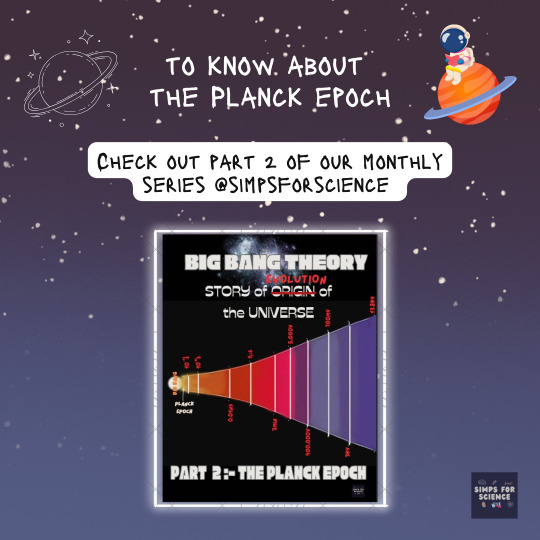
Quiz time!⏱️ What's the smallest possible unit of length?🤔 Nanometer? Femtometer?.. Well, if this was your guess, we're afraid you're wrong.😅 Ever heard of the Planck length?🙄 That's the tiniest scale of nature, the size of the universe in Planck Era. Swipe through this post ➡️ to fathom how small this scale is! Join us on our series - 'Big Bang Theory'‼️ to know more such fascinating facts about the cosmos 🌠
📸Image credits:
Max Planck - Max Planck Gesselschaft
Alden Mead - University of Minnesota
#max planck#planck epoch#physics#quantum physics#quantum mechanics#physicist#astrophysics#astronomy#universe#cosmos#cosmology#space#nasa#education#science#science facts#study blog#discover#scicomm#research scientist#explore#big bang#big bang theory#expanding universe#cool science#simps for science#comics#comic art
21 notes
·
View notes
Text
A summary
So, the collider project was the crowning achievement of my career. (Still pissed about it getting blown up, but whatever, I can say that until I'm blue in the face.)
But fuck it, it still ran and it still gave me data and I'm still going to claim the results, so here goes.
...
...
Oh, wait, did you expect me to post my actual data?? HAHA NO. You're getting a summary, because I'll be damned if I post my actual data on a public-facing report log. Fuck you. Read about it in the paper I'll eventually publish, with my name on it. I am not going to let people just nick everything I've been working for.
But here you go. Things my collider has suggested or proved:
You can make micro black holes with as little energy as 9.4 tera-electronvolts (TeV) (aka, you can make them in a sufficiently powerful collider). (The LHC has a max design capability of 6.5 TeV per beam so far. My collider was supposed to start at 4.5 TeV and scale up to 8 TeV after upgrades (for a total of 16 TeV).)
Micro black holes exist. (These are just tiny, tiny black holes. They’re actually quite safe, so long as you aren’t standing near them. They pop into existence, then evaporate (see below) and disappear.)
There’s more than three spatial dimensions. (Also see here.) (Considering only three spatial dimensions, the “black hole threshold” is WAY too high, and you won’t be able to make a black hole of any size in a TeV-capable collider. The Planck mass (a natural unit of mass derived from only natural constants) is indicated to be a minimum limit on black hole masses - and the calculations just don’t allow black holes in the TeV range when using only three dimensions plus time. So, in order for black holes to be possible in the TeV range, you have to have a way to scale gravity in a way that’s stronger than in our three spatial dimensions. Otherwise, you won’t have the right conditions for a black hole. With more than three spatial dimensions (personally, I prefer M-theory, a version of string theory which favors ten spatial dimensions plus time), gravity can operate throughout ALL those dimensions, and can scale differently, lowering the “black hole threshold” into the TeV range.)
Gravity works in more than 3 dimensions. (In order for everything above to work, gravity has to permeate more than three dimensions in order to actually scale properly.) (Additionally, the fact that appearing and collapsing black holes can “grab onto” space enough to shred it indicates that gravity does indeed affect space itself.)
Black holes do indeed evaporate. (This has been accepted for a long time - Hawking proposed it in the 70’s, hence why it’s often referred to as Hawking radiation. The old idea that “nothing escapes a black hole”? That’s a trick statement, because technically, black holes DO radiate stuff, and lose mass and energy when they do. (hence the nickname “evaporation”). We’ve never had experimental proof of it before, but now, we know from looking at the data from the collider’s test runs that the micro black holes DID indeed evaporate and disappear in a flash of energy.)
More evidence that gravitons should be a thing. (String theories predicted a graviton, a subatomic elementary particle that regulates gravity.)
Warping space can shred the fabric of spacetime. (This is where the magic happens! The collider creates streams of micro black holes, which have gravitational pull and “bend” space a little bit. Then, the micro black hole disappears, and space snaps back. However, if you have a ton of micro black holes doing that, it’s pulling space in all sorts of rather violent directions all at once, and actually rips the space. That’s where the dimensional “portal” opens up.)
Space is, indeed, elastic to some degree - either that, or it can move fluidly enough that it looks like it’s healing the tears. (The dimensional “portals” were only open while the collider was on, and closed up when the collider turned off.)
Space DOES seem to have some form of “surface tension” or resistive buoyancy - possibly gravity? - that pushes back. (When the original Parker got pushed into the beam by Green Goblin, it took effort to hold him there, as if he were being pushed back.)
Parallel universes exist.
Different laws of physics exist in those universes. (This one’s a little bit less hard-proven and a little more “strongly suggested,” in that the spiders’ glitching seems to almost be on an atomic level, hinting at different underlying base physics.)
There’s some as-of-yet unnamed phenomenon which allows parallel-universe “versions” of a person to be summoned by throwing DNA into the collider beam.
I could think of more, but I think that’s enough stuff for today.
Footnotes: Hey folks! Long time, no see!
First things first, don't take anything here as truth. This is a lot more speculative fiction!
Second, I'm not starting this blog up again. I don't have the time for it - each post typically took days to weeks to research and write, even though they're short posts, and while I loved writing them, I just can't fit it in.
However, I found this in my drafts today - it's been sitting here since 2019! - and I'm not sure why I never posted it. It's something I remember putting a LOT of work into, though, and someone might find it interesting! I remember I wanted to list out possible things that Liv's collider experiments would have implications for, and there's a number of things here about the fictional collider's functions that I hadn't gotten to touch on.
Honestly, I don't thoroughly remember enough to vet the concepts fully as of today, but it's all fictional anyway. Like I said, don't take anything here as truth! If one could operate a collider like Liv’s, and get those particular results, then it’s POSSIBLE it would imply things, BUT in OUR universe, they haven’t been proven (and, again, I'm not a physicist! I'm a hobbyist armed with books and Google, and there's a high chance I've misinterpreted things here or there).
Citations are in-text as links.
Concepts that already existed: These are generally accepted as either a "thing" or "viable theory" by physicists. Micro black holes, Hawking radiation, more than 3 dimensions, gravitons, M-theory.
Concepts that already existed, but are kind of shaky: making micro black holes in a collider, parallel universes.
Concepts that I totally made up based on the movie (and thinking way too hard about things): shredding spacetime, space having surface tension, different laws of physics in parallel universes, the “as-of-yet unnamed phenomenon” of the last one.
Voilá! If anyone has questions about any of the science here, feel free to shoot me a message or an ask! I’ve tried pretty hard to include real-life info to build off of, and to clearly indicate what parts I’m just making up!
4 notes
·
View notes
Note
I've been meaning to ask, are the armband controls on Okita to control her Dread Plate and Mind Plate implants?
The device(s) Okita wears on her arms are her own inventions. She's inquisitive by nature, and uses the device to help her usilise her telekinesis effectively, as well as for everyday life. She most likely stole a pokedex to make this
Okita struggles to use normal pokemon attacking moves, instead, over her lifetime she's perfected and refined her telekinesis down to the planck length, and manipulate quantum fields: i.e. She's able to use her telekinesis for alchemy, and roughly follows the alchemic laws of conservation and the first (irl) law of thermodynamics. 'Fun' fact: Instead of a Aura sphere, Okita creates appropriately sized black holes or pulsars with any matter around her to use as an attack. mangling her opponent. The only drawback, this attack can take up to a minute to prepare, leaving her vulnerable.

Thanks for the ask! @mel-the-pirate This was fun to answer ^^
26 notes
·
View notes
Text

Study proposes a test for the Anthropic Principle
The Anthropic Principle—stating that the universe we live in is fine-tuned to host life—was first proposed by Brandon Carter in 1973. Since then, it has sparked significant debate.
Now, a paper published in the Journal of Cosmology and Astroparticle Physics, authored by Nemanja Kaloper, a physicist from the Department of Physics and Astronomy at the University of California, Davis, and Alexander Westphal, a professor at the Deutsches Elektronen-Synchrotron (DESY), describes for the first time a way to experimentally test this assumption.
The anthropic principle (AP) can be formulated in different ways. These range from a simple description of the facts—"if we are here observing it, the universe evolved with the conditions necessary for the emergence of intelligent life," known as the weak AP—to something a bit more radical: "the universe had to evolve in a way that led to our existence."
This stronger interpretation, called the strong AP, often ventures into metaphysical territory, suggesting a kind of "design" and moving beyond the realm of scientific inquiry into the universe.
The problem with the AP, according to many scientists, is that it is not particularly useful as a scientific tool because it does not generate testable, quantifiable predictions that could both expand our knowledge and subject the principle to scrutiny. Without this, it remains more of a philosophical conjecture than a scientific hypothesis.
The AP does, however, suggest that for our universe to develop as a hospitable place for carbon-based life, it must have started with a set of rather specific initial conditions. We infer this by observing, for example, the values of certain constants used in the equations that describe the universe—such as the gravitational constant, the electron charge, and Planck's constant—which must be "just right." Otherwise, we would have a very different and, most importantly, inhospitable universe.
By establishing the precise initial conditions implied by the AP and calculating, based on current physical models, how the universe would have evolved to its present state, we could compare the outcome to actual astronomical observations. Any discrepancies between theory and reality would provide a measure of the validity of the AP.
The new work by Nemanja Kaloper and Alexander Westphal offers some specific predictions that could find observational confirmation in the coming years.
To understand their proposal, some key elements in cosmological research must be outlined:
Cosmic inflation
In the earliest moments of its existence, the universe underwent a period of rapid expansion: in just 10-36 seconds, it grew from an infinitesimal size (almost zero) to a macroscopic scale (some theories describe it as the size of a grape or a soccer ball). After this, the expansion slowed down, continuing at rates similar to those we observe today.
The physics during this early phase was highly unusual, dominated by quantum phenomena (governing the infinitely small) that influenced the subsequent evolution, enabling the formation of structures—galaxies, stars, and so on—that we see today. Although direct evidence for cosmic inflation has not yet been found, it is a robust theory with anticipated observational confirmations in the coming years.
Dark matter
You've probably heard of it: experimental observations tell us that a significant portion of the universe—about five-sixths of its matter—is composed of something we cannot directly observe. We call it dark matter, but its true nature remains unknown. Many hypotheses have been proposed, all awaiting experimental confirmation, which is expected in the near future.
Axions
One of the candidates for dark matter is the axion. These particles—or, more likely, an entire class of particles—are extremely light (much lighter than the electron, for instance). Axions were initially proposed to explain a quantum phenomenon known as CP symmetry violation, which involves the weak nuclear interaction, one of the four fundamental forces (the others being gravity, electromagnetism, and the strong nuclear interaction).
However, researchers noticed that certain characteristics of axions—believed to have formed in great abundance during cosmic inflation—align with those expected for dark matter, such as their minimal interactions with both themselves and ordinary matter. Observations of black holes could confirm their existence in the coming years.
Testing the AP involves combining these three elements.
"It is possible that the LiteBIRD satellite discovers primordial gravity waves close to the current limits, which match high-scale inflation," explains Kaloper. "Most cosmologists would feel this confirms high-scale inflation." LiteBIRD (Lite (Light) Satellite for the Study of B-mode Polarization) is an experiment that the Japanese Aerospace Exploration Agency (JAXA) plans to launch in 2032.
"It is also possible that we discover signs of ultralight axions by surveying supermassive black holes in the universe. The axions affect the spin-to-mass ratio of black holes, and this could be observed," Kaloper continues. Many experiments are already studying black holes, with more set to begin operating in the near future.
"Finally," adds Kaloper, "it is possible that future direct dark matter searches discover that dark matter is predominantly not made up of ultralight axions. In which case, we'd think that the anthropic principle fails."
However, this outcome is not guaranteed.
"On the other hand, if direct dark matter searches find that dark matter is, in fact, ultralight axion," Kaloper continues, "then I think we'd agree that the anthropic principle in fact passed this test; indeed, this might happen."
"I find it particularly interesting that both of these options might be experimentally tested in the not-too-distant future," Kaloper concludes.
"And that—as far as my collaborator and I know—our specific example is the first case where the anthropic principle might actually fail the test, as opposed to simply declaring that it does not apply.
"The point is, that the presence of high-scale inflation and ultralight axions with masses m > 10-19 eV would imply that dark matter 'must' be an axion: for typical initial conditions, we'd end up with way too much dark matter, and we'd desperately need the anthropic principle to constrain it.
"To find that axion is not dark matter, we'd infer that the initial conditions were not just unlikely (which can be fixed anthropically) but extremely unlikely, which really does not even fall under the domain of anthropic reasoning."
So, we will need to wait a few more years, perhaps even longer, to gather all the necessary evidence to either falsify or confirm the anthropic principle. But what if it proves unable to pass the test?
"Without changing any of the other premises (universality of gravity, early inflation and superradiant phenomena), the failure of our simple formulation of anthropics would suggest that different rules govern the initial conditions," explains Kaloper.
"Either different initial conditions are not equally probable, some being biased by new dynamics as yet not understood, or that some initial conditions are altogether impossible. Alternatively, the real theory of cosmology might be more complicated than we thought."
"One could also imagine more dramatic scenarios, but at least for now, to me those seem as flights of fancy," concludes Kaloper.
2 notes
·
View notes
Text
In my SF future history, the UN has given way to the Alliance of Nations. It retains a lot of UN organs (the UN retains a lot of League of Nations ones), including the IMF. In my future it issues a currency, called the “right”, short for Alliance Drawing Right, derived from the IMF Special Drawing Right of our day. Since the government issuing it is the “AN”, and it’s the currency used by everyone, its symbol is the one used in logic for “for all”: ∀. (I think it was adopted partly in a situation analogous to the creation of the Allied Military Currency and Military Payment Certificates after World War Two: the AN having arisen to replace the UN for similar reasons to the UN replacing the League, namely a big fuckoff war the previous organization didn’t prevent.)
My main aliens, on the other hand, use what is technically a representative currency, like the gold standard, but based on an abstraction: the price of enough of an idealized animal fat (they’re obligate carnivores) to supply their metabolism with a given amount of energy. A hundredth of a Planck energy is about the daily calorie intake of a predator in the jaguar-to-tiger size range, like the aliens. (Unlike most Planck units, the energy one is huge: about 2 gigajoules, because the others are so small and there’s division involved.) I’m still trying to figure out what they call it, though—might just be the “energy, dietary”, and they just measure it in actual energy-units.
I think the aliens using, basically, calories-worth of lard, as a currency standard, grew out of similar causes to the aforementioned Allied Military Currency and Military Payment Certificates, but less catastrophic. Something like, people near the forts of the various empires accepted military ration points as legal tender, so those became a standard medium of exchange, eventually spreading over their world like the Spanish dollar. Obviously, of course, you aren’t originally measuring that directly in calories, but in volumes of fat—like how the productivity of a daimyō’s domain in feudal and shogunate Japan was assessed in units of koku (about 180 liters), generally considered the rice required to feed a person for a year.
4 notes
·
View notes